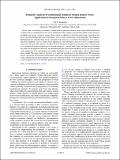Symmetry analysis of translational symmetry broken density waves: Application to hexagonal lattices in two dimensions
Author(s)
Venderbos, Jorn W. F.
DownloadPhysRevB.93.115107.pdf (873.4Kb)
PUBLISHER_POLICY
Publisher Policy
Article is made available in accordance with the publisher's policy and may be subject to US copyright law. Please refer to the publisher's site for terms of use.
Terms of use
Metadata
Show full item recordAbstract
In this work we introduce a symmetry classification for electronic density waves which break translational symmetry due to commensurate wave-vector modulations. The symmetry classification builds on the concept of extended point groups: symmetry groups which contain, in addition to the lattice point group, translations that do not map the enlarged unit cell of the density wave to itself, and become “nonsymmorphic”-like elements. Multidimensional representations of the extended point group are associated with degenerate wave vectors. Electronic properties such as (nodal) band degeneracies and topological character can be straightforwardly addressed, and often follow directly. To further flesh out the idea of symmetry, the classification is constructed so as to manifestly distinguish time-reversal invariant charge (i.e., site and bond) order, and time-reversal breaking flux order. For the purpose of this work, we particularize to spin-rotation invariant density waves. As a first example of the application of the classification we consider the density waves of a simple single- and two-orbital square lattice model. The main objective, however, is to apply the classification to two-dimensional (2D) hexagonal lattices, specifically the triangular and the honeycomb lattices. The multicomponent density waves corresponding to the commensurate M-point ordering vectors are worked out in detail. To show that our results generally apply to 2D hexagonal lattices, we develop a general low-energy SU(3) theory of (spinless) saddle-point electrons.
Date issued
2016-03Department
Massachusetts Institute of Technology. Department of PhysicsJournal
Physical Review B
Publisher
American Physical Society
Citation
Venderbos, J. W. F. “Symmetry Analysis of Translational Symmetry Broken Density Waves: Application to Hexagonal Lattices in Two Dimensions.” Physical Review B 93, no. 11 (March 3, 2016). © 2016 American Physical Society
Version: Final published version
ISSN
2469-9950
2469-9969